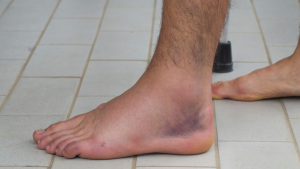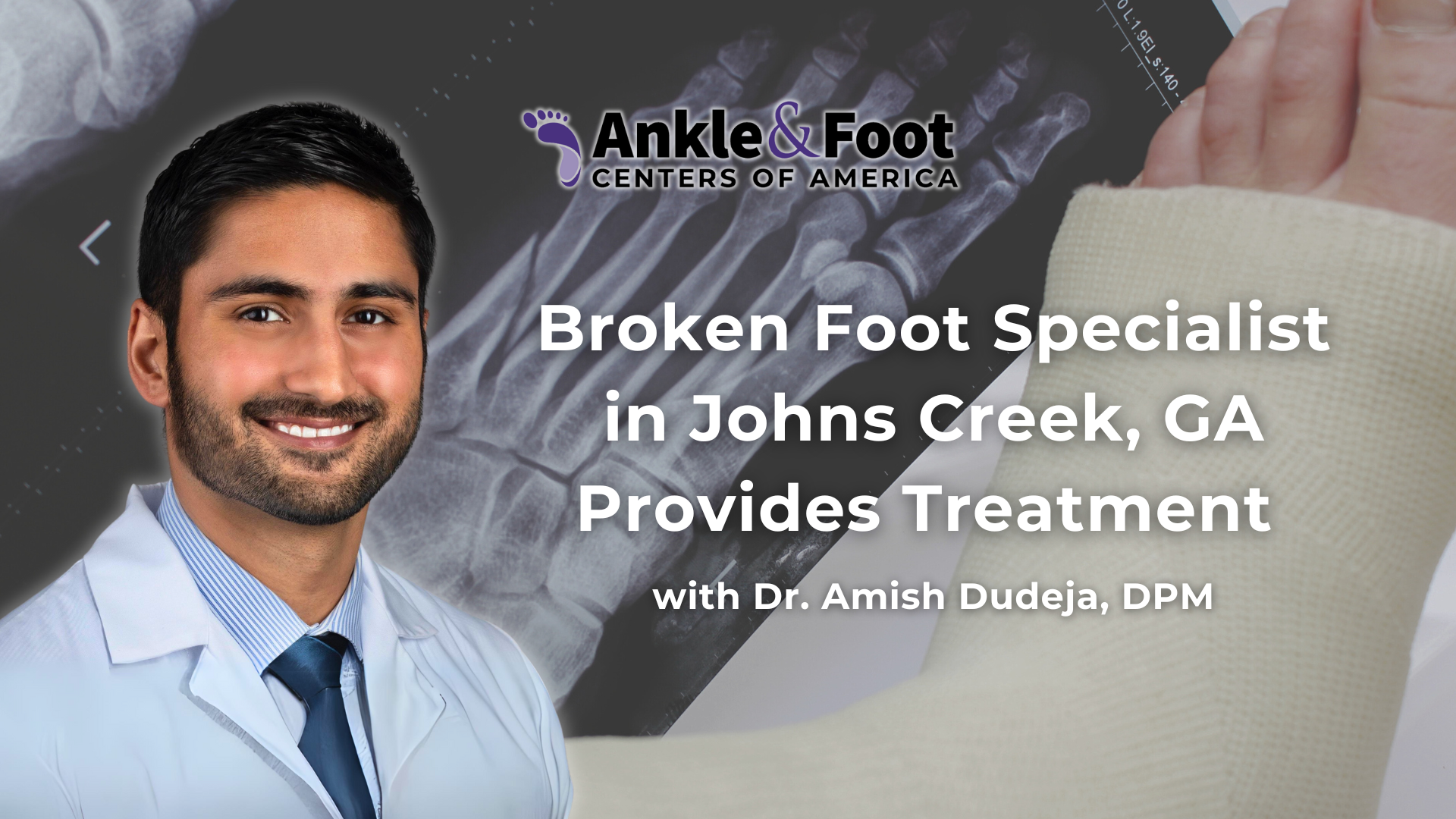Table of Contents
Understanding a Broken Foot
A broken foot happens when trauma or stress fractures one or more of the 26 bones in your foot. Accidents, falls, sports injuries, or repetitive overuse often cause these types of fractures. Whether you’re dealing with a small crack or a serious break, a broken foot can severely limit your mobility and disrupt your daily routine.
Seeing a podiatrist promptly is essential to ensure the injury heals properly and to avoid long-term complications.
What Does a Broken Foot Look Like?
 A broken foot often presents noticeable signs that indicate the severity of the injury. You may see swelling, bruising, or even an unnatural alignment of the foot. In some cases, bones may protrude through the skin, signaling a severe fracture that requires immediate medical attention.
A broken foot often presents noticeable signs that indicate the severity of the injury. You may see swelling, bruising, or even an unnatural alignment of the foot. In some cases, bones may protrude through the skin, signaling a severe fracture that requires immediate medical attention.
Common Signs and Symptoms
Recognizing the symptoms of a broken foot can help you take quick action and seek professional care. Some of the most common symptoms include:
- Intense pain at the site of the fracture, especially when bearing weight
- Swelling and tenderness around the injured area
- Bruising or discoloration
- Deformity or abnormal positioning of the toes or foot
- Difficulty walking or moving the foot
- Numbness or tingling in severe cases
What to Do If You Suspect a Broken Foot
If you’re experiencing symptoms of a broken foot, it’s important to consult a podiatrist. These medical professionals specialize in foot and ankle conditions and can provide the right treatment to promote proper healing.
Prompt diagnosis and treatment are critical to ensuring that the bones heal correctly and preventing complications, such as chronic pain or improper alignment. In some cases, immobilization with a boot for a broken foot may be necessary to promote healing.
Getting a professional diagnosis will help you understand the best course of treatment and what to expect during the recovery process. Don’t delay seeking care—early intervention leads to faster and more successful recovery.
Treatment Options for a Broken Foot
When dealing with a broken foot, prompt and effective treatment is essential to ensure proper healing and prevent long-term complications. Depending on the severity and location of the fracture, treatment may involve non-surgical methods or surgical intervention. Here are the most common treatment options for a broken foot.
Non-Surgical Treatment
Here are some of the most common non-surgical approaches:
Immobilization with a Boot or Cast:
-
Wearing a boot for a broken foot helps immobilize the injury, allowing the bones to heal correctly.
-
A cast may also be used for more severe fractures to completely restrict movement.
-
The specialist will determine the most suitable option based on the location and severity of the break.
Rest and Limited Activity:
-
Resting the affected foot is crucial to prevent further damage.
-
Weight-bearing may be restricted, and crutches or a walker might be recommended to reduce pressure on the foot.
 Ice and Elevation:
Ice and Elevation:
-
Applying ice to the injured area helps reduce swelling and inflammation.
-
Elevating the foot above heart level can minimize swelling and improve circulation.
Pain Management:
-
Over-the-counter pain relievers, such as ibuprofen or acetaminophen, can help manage discomfort.
-
In some cases, the specialist may prescribe stronger pain medication, especially if the injury is severe.
Surgical Treatment
Surgery realigns the bones and secures them in place to ensure proper healing.
Open Reduction and Internal Fixation (ORIF):
-
During this procedure, the surgeon makes an incision to access the broken bones.
-
Metal screws, plates, or pins are used to hold the bones in their correct positions.
-
This method is commonly used for fractures that are severely displaced or unstable.
External Fixation:
-
In some cases, external devices are used to stabilize the foot from the outside.
-
Metal pins or wires are inserted into the bone and connected to an external frame to hold the fragments in alignment.
Post-Surgical Care:
-
After surgery, the foot will be immobilized in a cast or boot, and physical therapy may be recommended to restore strength and flexibility.
-
The recovery period can vary based on the extent of the injury and the type of surgery performed.
Recovery and Rehabilitation
 Several factors influence how long it takes to recover from a broken foot, including the severity of the fracture and whether surgery was necessary. Generally, recovery can take anywhere from 6 to 12 weeks.
Several factors influence how long it takes to recover from a broken foot, including the severity of the fracture and whether surgery was necessary. Generally, recovery can take anywhere from 6 to 12 weeks.
Rehabilitation may include:
-
Gradual weight-bearing exercises to restore mobility.
-
Physical therapy to regain strength and balance.
-
Wearing a supportive boot during the transition back to normal activities.

Conclusion
If you suspect a broken foot, don’t wait to seek professional care. Ignoring the injury or delaying treatment can lead to complications like improper healing, chronic pain, or even long-term mobility issues. Fortunately, expert care is available right here in Johns Creek, GA.
At Ankle & Foot Centers of America, our skilled specialists are dedicated to providing comprehensive treatment for broken feet, from diagnosis to recovery. Whether you need a boot for a broken foot or surgical intervention, we’ll develop a personalized plan to get you back on your feet as quickly and safely as possible.
Don’t let a broken foot hold you back—contact us today to schedule your appointment and take the first step toward recovery.






